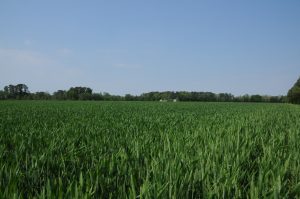Nathan M. Kleczewski, Extension Plant Pathologist, University of Delaware
We have confirmed stripe rust activity in Southern Delaware. As the disease is active in S. DE, I suspect it also is present in parts of lower MD as well. Most wheat in the southern part of the DE/MD region is about 7 days from flag leaf, and cooler weather is forecast over the next ten days. Dynagro Shirley and Dynagro 9600 appear to be highly susceptible. Barley is infected by a different species of the rust pathogen and is not at risk.
Growers should check their fields and consult their seed catalogues for stripe rust resistance ratings. Varieties with excellent or very good stripe rust ratings should not be at risk for significant damage from this disease. Susceptible varieties may need a fungicide application if stripe rust is detected. Group 3 (DMI) and premix fungicides containing a DMA (Stratego YLD, Quilt Xcel, Aproach Prima, Priaxor, etc.) will provide excellent control.
***Stripe rust has also been confirmed in St Mary’s County, MD on Sisson variety wheat. An adjacent field of Jamestown wheat was still clean (4/12/2017) – Ben Beale, St Mary’s County Extension***




 s likely damaged much of the wheat crop in Kentucky. The extent and severity of the damage will be better known one to two weeks after the freeze when baseline estimates can be made. Normally, producers would have three options to deal with wheat stands that have been damaged at this stage:
s likely damaged much of the wheat crop in Kentucky. The extent and severity of the damage will be better known one to two weeks after the freeze when baseline estimates can be made. Normally, producers would have three options to deal with wheat stands that have been damaged at this stage: